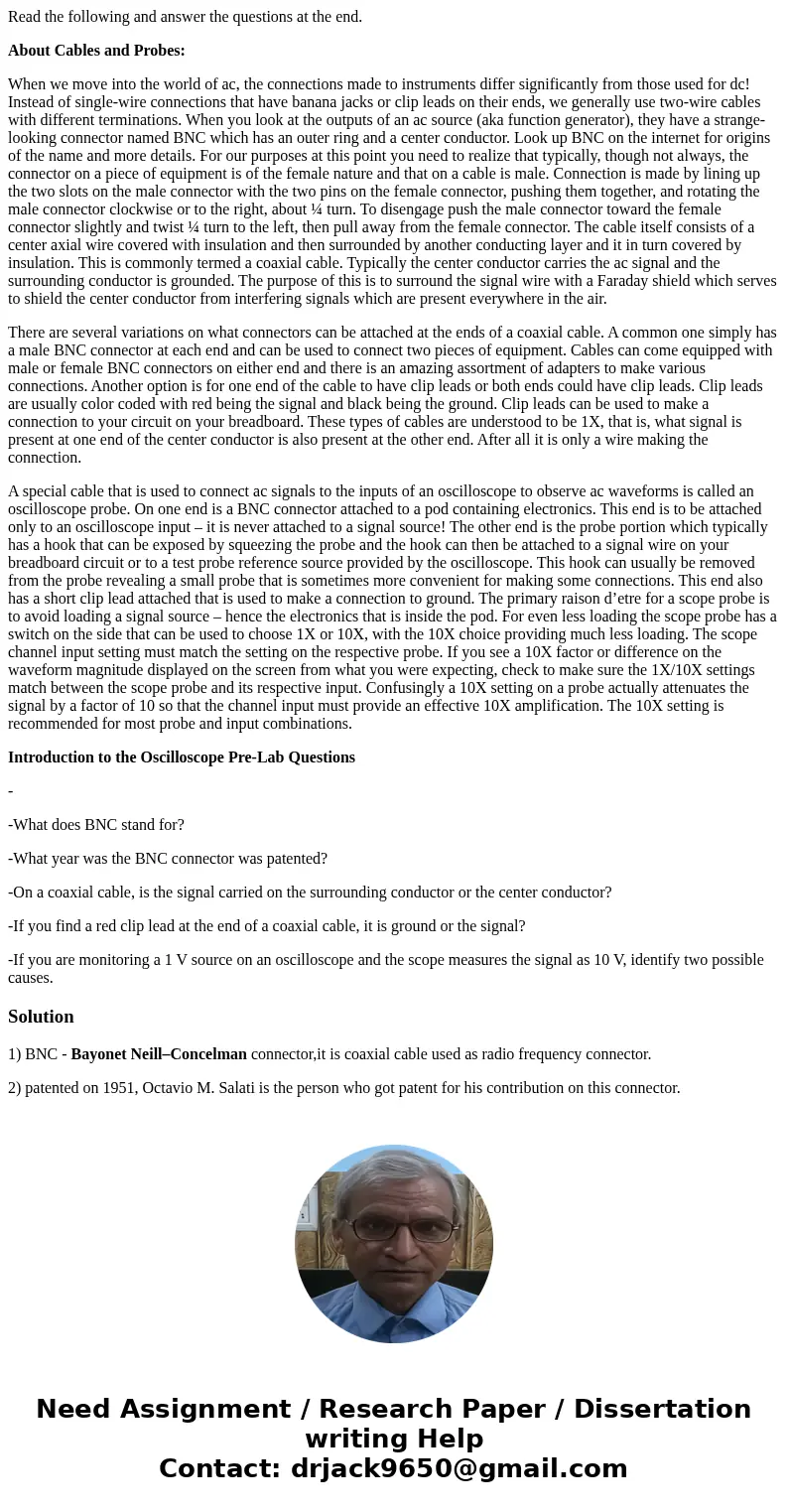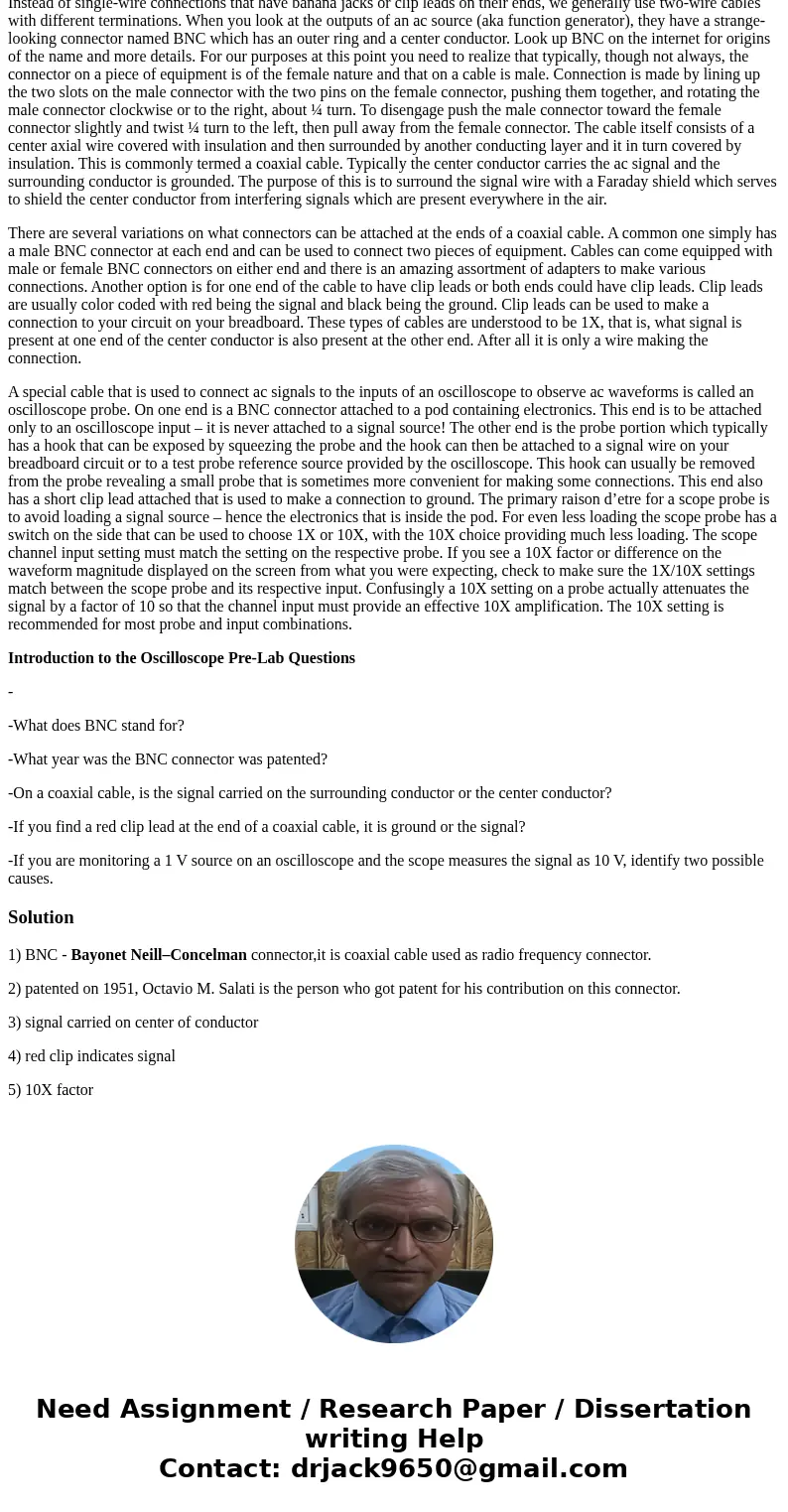Read the following and answer the questions at the end About
Read the following and answer the questions at the end.
About Cables and Probes:
When we move into the world of ac, the connections made to instruments differ significantly from those used for dc! Instead of single-wire connections that have banana jacks or clip leads on their ends, we generally use two-wire cables with different terminations. When you look at the outputs of an ac source (aka function generator), they have a strange-looking connector named BNC which has an outer ring and a center conductor. Look up BNC on the internet for origins of the name and more details. For our purposes at this point you need to realize that typically, though not always, the connector on a piece of equipment is of the female nature and that on a cable is male. Connection is made by lining up the two slots on the male connector with the two pins on the female connector, pushing them together, and rotating the male connector clockwise or to the right, about ¼ turn. To disengage push the male connector toward the female connector slightly and twist ¼ turn to the left, then pull away from the female connector. The cable itself consists of a center axial wire covered with insulation and then surrounded by another conducting layer and it in turn covered by insulation. This is commonly termed a coaxial cable. Typically the center conductor carries the ac signal and the surrounding conductor is grounded. The purpose of this is to surround the signal wire with a Faraday shield which serves to shield the center conductor from interfering signals which are present everywhere in the air.
There are several variations on what connectors can be attached at the ends of a coaxial cable. A common one simply has a male BNC connector at each end and can be used to connect two pieces of equipment. Cables can come equipped with male or female BNC connectors on either end and there is an amazing assortment of adapters to make various connections. Another option is for one end of the cable to have clip leads or both ends could have clip leads. Clip leads are usually color coded with red being the signal and black being the ground. Clip leads can be used to make a connection to your circuit on your breadboard. These types of cables are understood to be 1X, that is, what signal is present at one end of the center conductor is also present at the other end. After all it is only a wire making the connection.
A special cable that is used to connect ac signals to the inputs of an oscilloscope to observe ac waveforms is called an oscilloscope probe. On one end is a BNC connector attached to a pod containing electronics. This end is to be attached only to an oscilloscope input – it is never attached to a signal source! The other end is the probe portion which typically has a hook that can be exposed by squeezing the probe and the hook can then be attached to a signal wire on your breadboard circuit or to a test probe reference source provided by the oscilloscope. This hook can usually be removed from the probe revealing a small probe that is sometimes more convenient for making some connections. This end also has a short clip lead attached that is used to make a connection to ground. The primary raison d’etre for a scope probe is to avoid loading a signal source – hence the electronics that is inside the pod. For even less loading the scope probe has a switch on the side that can be used to choose 1X or 10X, with the 10X choice providing much less loading. The scope channel input setting must match the setting on the respective probe. If you see a 10X factor or difference on the waveform magnitude displayed on the screen from what you were expecting, check to make sure the 1X/10X settings match between the scope probe and its respective input. Confusingly a 10X setting on a probe actually attenuates the signal by a factor of 10 so that the channel input must provide an effective 10X amplification. The 10X setting is recommended for most probe and input combinations.
Introduction to the Oscilloscope Pre-Lab Questions
-
-What does BNC stand for?
-What year was the BNC connector was patented?
-On a coaxial cable, is the signal carried on the surrounding conductor or the center conductor?
-If you find a red clip lead at the end of a coaxial cable, it is ground or the signal?
-If you are monitoring a 1 V source on an oscilloscope and the scope measures the signal as 10 V, identify two possible causes.
Solution
1) BNC - Bayonet Neill–Concelman connector,it is coaxial cable used as radio frequency connector.
2) patented on 1951, Octavio M. Salati is the person who got patent for his contribution on this connector.
3) signal carried on center of conductor
4) red clip indicates signal
5) 10X factor


 Homework Sourse
Homework Sourse